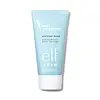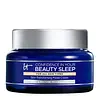What's inside
What's inside
 Key Ingredients
Key Ingredients

 Benefits
Benefits

 Concerns
Concerns

 Ingredients Side-by-side
Ingredients Side-by-side

Water
Skin ConditioningGlycerin
HumectantCetyl Ethylhexanoate
EmollientCaprylic/Capric Triglyceride
MaskingButyrospermum Parkii Butter
Skin ConditioningDimethicone
EmollientCetearyl Alcohol
EmollientGlyceryl Stearate
EmollientPEG-100 Stearate
PEG-8
HumectantGlycereth-26
HumectantTrehalose
HumectantPalmitoyl Tripeptide-1
Skin ConditioningPalmitoyl Tetrapeptide-7
Skin ConditioningCeramide NP
Skin ConditioningCeramide AP
Skin ConditioningCeramide EOP
Skin ConditioningSoluble Collagen
HumectantSodium Hyaluronate
HumectantPhytosphingosine
Skin ConditioningHelianthus Annuus Seed Oil
EmollientTocopherol
AntioxidantCholesterol
EmollientButylene Glycol
Humectant1,2-Hexanediol
Skin ConditioningSorbitan Stearate
EmulsifyingPolysorbate 20
EmulsifyingSodium Lauroyl Lactylate
EmulsifyingXanthan Gum
EmulsifyingAcrylates/C10-30 Alkyl Acrylate Crosspolymer
Emulsion StabilisingCarbomer
Emulsion StabilisingPhenoxyethanol
PreservativeCaprylyl Glycol
EmollientEthylhexylglycerin
Skin ConditioningParfum
MaskingGeraniol
PerfumingLinalool
PerfumingDisodium EDTA
Tromethamine
BufferingWater, Glycerin, Cetyl Ethylhexanoate, Caprylic/Capric Triglyceride, Butyrospermum Parkii Butter, Dimethicone, Cetearyl Alcohol, Glyceryl Stearate, PEG-100 Stearate, PEG-8, Glycereth-26, Trehalose, Palmitoyl Tripeptide-1, Palmitoyl Tetrapeptide-7, Ceramide NP, Ceramide AP, Ceramide EOP, Soluble Collagen, Sodium Hyaluronate, Phytosphingosine, Helianthus Annuus Seed Oil, Tocopherol, Cholesterol, Butylene Glycol, 1,2-Hexanediol, Sorbitan Stearate, Polysorbate 20, Sodium Lauroyl Lactylate, Xanthan Gum, Acrylates/C10-30 Alkyl Acrylate Crosspolymer, Carbomer, Phenoxyethanol, Caprylyl Glycol, Ethylhexylglycerin, Parfum, Geraniol, Linalool, Disodium EDTA, Tromethamine
Water
Skin ConditioningDimethicone
EmollientGlycerin
HumectantSimmondsia Chinensis Seed Oil
EmollientHydrogenated Castor Oil Dimer Dilinoleate
Skin ConditioningPropanediol
SolventAlcohol Denat.
AntimicrobialCaprylic/Capric Triglyceride
MaskingCetyl Alcohol
EmollientCetyl Hydroxyethylcellulose
Emulsion StabilisingOctyldodecanol
EmollientSilica
AbrasivePhenoxyethanol
PreservativeAlbizia Julibrissin Bark Extract
MaskingCaprylyl Glycol
EmollientParfum
MaskingPoloxamer 338
EmulsifyingCapryloyl Salicylic Acid
ExfoliatingLimonene
PerfumingAdenosine
Skin ConditioningTocopherol
AntioxidantXanthan Gum
EmulsifyingDisodium EDTA
Linalool
PerfumingCeramide NP
Skin ConditioningHydroxypalmitoyl Sphinganine
Skin ConditioningSilica Dimethyl Silylate
EmollientHydrated Silica
AbrasiveSodium Hyaluronate
HumectantPolysorbate 60
EmulsifyingCitronellol
PerfumingSodium Benzoate
MaskingCI 16035
Cosmetic ColorantGeraniol
PerfumingCereus Grandiflorus Flower Extract
Skin ConditioningCitral
PerfumingDarutoside
Skin ConditioningCI 42090
Cosmetic ColorantGlucose
HumectantLactic Acid
BufferingPotassium Sorbate
PreservativeWater, Dimethicone, Glycerin, Simmondsia Chinensis Seed Oil, Hydrogenated Castor Oil Dimer Dilinoleate, Propanediol, Alcohol Denat., Caprylic/Capric Triglyceride, Cetyl Alcohol, Cetyl Hydroxyethylcellulose, Octyldodecanol, Silica, Phenoxyethanol, Albizia Julibrissin Bark Extract, Caprylyl Glycol, Parfum, Poloxamer 338, Capryloyl Salicylic Acid, Limonene, Adenosine, Tocopherol, Xanthan Gum, Disodium EDTA, Linalool, Ceramide NP, Hydroxypalmitoyl Sphinganine, Silica Dimethyl Silylate, Hydrated Silica, Sodium Hyaluronate, Polysorbate 60, Citronellol, Sodium Benzoate, CI 16035, Geraniol, Cereus Grandiflorus Flower Extract, Citral, Darutoside, CI 42090, Glucose, Lactic Acid, Potassium Sorbate
 Reviews
Reviews

Ingredients Explained
These ingredients are found in both products.
Ingredients higher up in an ingredient list are typically present in a larger amount.
This ingredient is an emollient, solvent, and texture enhancer. It is considered a skin-softener by helping the skin prevent moisture loss.
It helps thicken a product's formula and makes it easier to spread by dissolving clumping compounds.
Caprylic Triglyceride is made by combining glycerin with coconut oil, forming a clear liquid.
While there is an assumption Caprylic Triglyceride can clog pores due to it being derived from coconut oil, there is no research supporting this.
Learn more about Caprylic/Capric TriglycerideCaprylyl Glycol is a humectant and emollient, meaning it attracts and preserves moisture.
It is a common ingredient in many products, especially those designed to hydrate skin. The primary benefits are retaining moisture, skin softening, and promoting a healthy skin barrier.
Though Caprylyl Glycol is an alcohol derived from fatty acids, it is not the kind that can dry out skin.
This ingredient is also used as a preservative to extend the life of products. It has slight antimicrobial properties.
Learn more about Caprylyl GlycolCeramide NP is a type of ceramide and formally known as ceramide 3.
Ceramides are intercellular lipids naturally found in our skin that bonds dead skin cells together to create a barrier. They are known for their ability to hold water and thus are a great ingredient for dry skin.
Ceramides are an important building block for our skin barrier. A stronger barrier helps the skin look more firm and hydrated. By bolstering the skin ceramides act as a barrier against irritating ingredients. This can help with inflammation as well.
If you would like to eat ceramides, sweet potatoes contain a small amount.
Read more about other common types of ceramides here:
Ceramide AP
Ceramide EOP
Dimethicone is a type of synthetic silicone created from natural materials such as quartz.
What it does:
Dimethicone comes in different viscosities:
Depending on the viscosity, dimethicone has different properties.
Ingredients lists don't always show which type is used, so we recommend reaching out to the brand if you have questions about the viscosity.
This ingredient is unlikely to cause irritation because it does not get absorbed into skin. However, people with silicone allergies should be careful about using this ingredient.
Note: Dimethicone may contribute to pilling. This is because it is not oil or water soluble, so pilling may occur when layered with products. When mixed with heavy oils in a formula, the outcome is also quite greasy.
Learn more about DimethiconeDisodium EDTA plays a role in making products more stable by aiding other preservatives.
It is a chelating agent, meaning it neutralizes metal ions that may be found in a product.
Disodium EDTA is a salt of edetic acid and is found to be safe in cosmetic ingredients.
Learn more about Disodium EDTAGeraniol is used to add fragrance/parfum to a product. It is the main component of citronellol. It is a monoterpenoid and an alcohol.
Monoterpenes are naturally found in many parts of different plants.
Geraniol can be found in many essential oils including Rose Oil and Citronella Oil. The scent of Geraniol is often described as "rose-like". Many foods also contain Geraniol for fruit flavoring.
Geraniol can irritate the skin when exposed to air. However, irritation depends on the ability of geraniol to penetrate into the skin. In general, geraniol is not able to penetrate skin easily.
Geraniol is colorless and has low water-solubility. However, it is soluble in common organic solvents.
Like citronellol, it is a natural insect repellent.
2,6-Octadien-1-ol, 3,7-dimethyl-, (2E)-
Learn more about GeraniolGlycerin is already naturally found in your skin. It helps moisturize and protect your skin.
A study from 2016 found glycerin to be more effective as a humectant than AHAs and hyaluronic acid.
As a humectant, it helps the skin stay hydrated by pulling moisture to your skin. The low molecular weight of glycerin allows it to pull moisture into the deeper layers of your skin.
Hydrated skin improves your skin barrier; Your skin barrier helps protect against irritants and bacteria.
Glycerin has also been found to have antimicrobial and antiviral properties. Due to these properties, glycerin is often used in wound and burn treatments.
In cosmetics, glycerin is usually derived from plants such as soybean or palm. However, it can also be sourced from animals, such as tallow or animal fat.
This ingredient is organic, colorless, odorless, and non-toxic.
Glycerin is the name for this ingredient in American English. British English uses Glycerol/Glycerine.
Learn more about GlycerinLinalool is a fragrance and helps add scent to products. It's derived from common plants such as cinnamon, mint, citrus, and lavender.
Like Limonene, this ingredient oxidizes when exposed to air. Oxidized linalool can cause allergies and skin sensitivity.
This ingredient has a scent that is floral, spicy tropical, and citrus-like.
Learn more about LinaloolParfum is a catch-all term for an ingredient or more that is used to give a scent to products.
Also called "fragrance", this ingredient can be a blend of hundreds of chemicals or plant oils. This means every product with "fragrance" or "parfum" in the ingredients list is a different mixture.
For instance, Habanolide is a proprietary trade name for a specific aroma chemical. When used as a fragrance ingredient in cosmetics, most aroma chemicals fall under the broad labeling category of “FRAGRANCE” or “PARFUM” according to EU and US regulations.
The term 'parfum' or 'fragrance' is not regulated in many countries. In many cases, it is up to the brand to define this term.
For instance, many brands choose to label themselves as "fragrance-free" because they are not using synthetic fragrances. However, their products may still contain ingredients such as essential oils that are considered a fragrance by INCI standards.
One example is Calendula flower extract. Calendula is an essential oil that still imparts a scent or 'fragrance'.
Depending on the blend, the ingredients in the mixture can cause allergies and sensitivities on the skin. Some ingredients that are known EU allergens include linalool and citronellol.
Parfum can also be used to mask or cover an unpleasant scent.
The bottom line is: not all fragrances/parfum/ingredients are created equally. If you are worried about fragrances, we recommend taking a closer look at an ingredient. And of course, we always recommend speaking with a professional.
Learn more about ParfumPhenoxyethanol is a preservative that has germicide, antimicrobial, and aromatic properties. Studies show that phenoxyethanol can prevent microbial growth. By itself, it has a scent that is similar to that of a rose.
It's often used in formulations along with Caprylyl Glycol to preserve the shelf life of products.
Sodium Hyaluronate is hyaluronic acid's salt form. It is commonly derived from the sodium salt of hyaluronic acid.
Like hyaluronic acid, it is great at holding water and acts as a humectant. This makes it a great skin hydrating ingredient.
Sodium Hyaluronate is naturally occurring in our bodies and is mostly found in eye fluid and joints.
These are some other common types of Hyaluronic Acid:
Learn more about Sodium HyaluronateTocopherol (also known as Vitamin E) is a common antioxidant used to help protect the skin from free-radicals and strengthen the skin barrier. It's also fat soluble - this means our skin is great at absorbing it.
Vitamin E also helps keep your natural skin lipids healthy. Your lipid skin barrier naturally consists of lipids, ceramides, and fatty acids. Vitamin E offers extra protection for your skin’s lipid barrier, keeping your skin healthy and nourished.
Another benefit is a bit of UV protection. Vitamin E helps reduce the damage caused by UVB rays. (It should not replace your sunscreen). Combining it with Vitamin C can decrease sunburned cells and hyperpigmentation after UV exposure.
You might have noticed Vitamin E + C often paired together. This is because it is great at stabilizing Vitamin C. Using the two together helps increase the effectiveness of both ingredients.
There are often claims that Vitamin E can reduce/prevent scarring, but these claims haven't been confirmed by scientific research.
Learn more about TocopherolWater. It's the most common cosmetic ingredient of all. You'll usually see it at the top of ingredient lists, meaning that it makes up the largest part of the product.
So why is it so popular? Water most often acts as a solvent - this means that it helps dissolve other ingredients into the formulation.
You'll also recognize water as that liquid we all need to stay alive. If you see this, drink a glass of water. Stay hydrated!
Learn more about WaterXanthan gum is used as a stabilizer and thickener within cosmetic products. It helps give products a sticky, thick feeling - preventing them from being too runny.
On the technical side of things, xanthan gum is a polysaccharide - a combination consisting of multiple sugar molecules bonded together.
Xanthan gum is a pretty common and great ingredient. It is a natural, non-toxic, non-irritating ingredient that is also commonly used in food products.
Learn more about Xanthan Gum